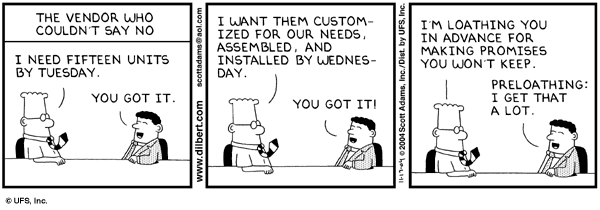o The Japanese Sigh - You do a sharp intake of breath from the corners of your mouth and exhale, saying "That would be very difficult..." In Japan, this means "No #$%&ing way." Most people outside of Japan also get the hint.The bottom line is that I give my customers the truth on when they'll get their product and what they can get - I just might lie as to the reason why.
o Lie to Tell The Truth - This requires you to tell one lie so you can tell the customer the truth without pissing him off. For example, I had two customers come in with urgent design requests at the same time. I had to give the design team to the more important customer, so the other customer had to cool their heels for a week. I wasn't going to lie and say their design would be ready in a week, and I didn't want to tell them that they got bumped for another customer. So I made up an Asian holiday, Buddha's Harvest Moon Festival, ("It's sort of like their Thanksgiving"), and said the design team was out for a week visiting their ancestral homes. Being culturally attuned, the customer moved his request out a week. Everyone was happy.
o I'll Get Back To You On That - And then don't. Yeah, it's an old trick, and only works in certain circumstances (mainly existing customers who have high switching costs). Is this better or worse than setting unrealistic expectations? Your call.
o What the President/CEO/Chairman Really Meant Was... - This is cleaning up after a higher-up pulled what the vendor did in the Dilbert strip. You can't go in and say "no" after the CEO promised it, so it is a delicate dance of re-interpreting the execu-speak that had been uttered by the upper echelon. It usually works, maybe because customers also have CEOs who do the exact same thing to them.
o Roll the #@$* Downhill - This goes something along the lines of "Look, my factory is ready to go and we have no problems. The problem is that the lead-times of your raw materials are pushing out the schedule." This basically just shifts the blame on someone else further down the supply chain while you scramble to get your factory up and running. This tactic is particularly useful if your customer doesn't know the real leadtimes of his raw materials.
Thursday, November 18, 2004
How to Say No and Keep the Account
This is definitely not me:
Subscribe to:
Post Comments (Atom)


No comments:
Post a Comment